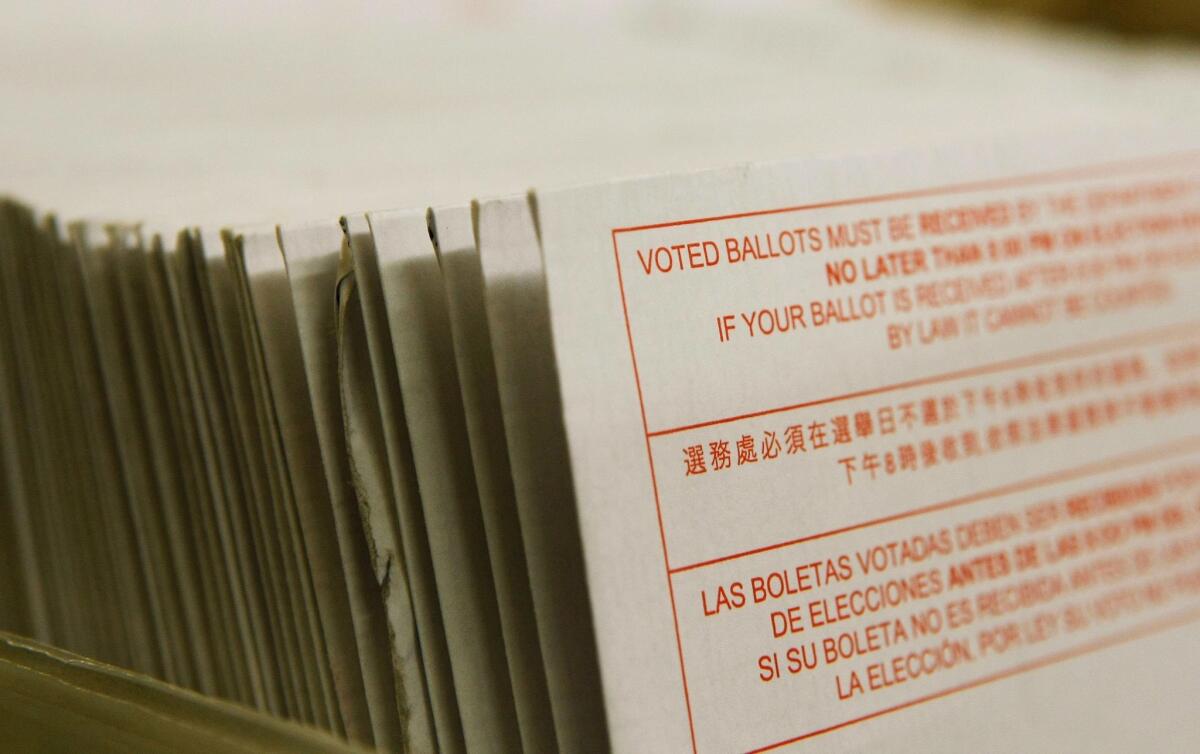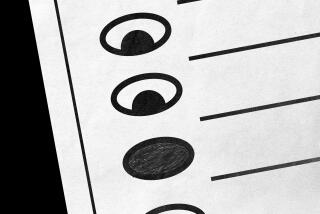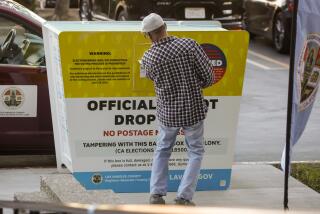Check your mailbox: 21 million California ballots are on their way to voters

For the first time in California history, a ballot will make its way in the mail this week to every registered California voter, a decision made in response to the COVID-19 pandemic that will reshape the election experience as well as the strategies of campaigns and candidates.
More than 21 million ballots will be mailed, more than in any state in the nation. Most will arrive this week, though some counties began the process almost two weeks ago. State law requires absentee ballots to be mailed no later than Monday, 29 days before the Nov. 3 election.
Few states have moved more decisively toward voting by mail over the last two decades than California, and the results have been striking. At least two-thirds of the ballots cast in the three most recent statewide elections had been mailed to voters, peaking at 72% of all votes recorded in the March primary.
Even so, millions of voters have bucked the trend and continued to vote in person on election day, and millions more don’t often participate or are newly registered. Should those two groups decide to use the ballot that arrives in the mail, they will have to abide by voting rules that might not be easily understood.
“Yes, it’s a big convenience,” said Kim Alexander, president of the nonpartisan California Voter Foundation. “But it shifts the responsibility for getting all the steps right from a poll worker to the voter.”
Researchers have estimated that the average California election in the last decade saw an average of 1.7% of vote-by-mail ballots
rejected for a variety of reasons. Based on voter turnout in the 2016 presidential election — which some think will be surpassed this year — the historical average would translate into almost 250,000 ballots not being counted.
Last month, Alexander’s organization released a detailed review of rejected absentee ballots in three counties from the November 2018 election. The top three reasons were that voters returned them too late, they didn’t sign the ballot envelope or the signature provided didn’t match the one on file.
“We have this persistent, stubborn ballot rejection problem,” she said. “It’s heartbreaking when people’s ballots are rejected.”
Even though they are mailed a ballot, some Californians will undoubtedly insist on participating in person. Voting by mail has not been popular everywhere — most notably in Los Angeles County, home to more than 5.6 million voters.
“In L.A. County, the data shows that we cannot rely on a single option for voting,” said Dean Logan, the county’s registrar of voters. “Voting by mail is a great safeguard. But we know, based on the data, that there are communities and voters across L.A. County that prefer to vote in person or need the services provided by voting in person.”
In May, Gov. Gavin Newsom took the unprecedented step of issuing a statewide order for voting by mail in November, making clear that the mandate was for only one election and necessary to limit the spread of the coronavirus. The Legislature ratified the plan in June, and additional rules were put in place for those who will vote in person.
No doubt some Californians will embrace the flexibility that voting away from a polling place offers. In 1979, the state eliminated the need for an excuse to receive an absentee ballot, a system still used in some parts of the country. The option to choose permanent absentee voting was created in 2002. The changes have proved popular; in all but two statewide elections since 2008, the majority of votes were not cast at a traditional polling place.
Some communities have gone much further. Four rural counties had no in-person voting locations in March. Fourteen more counties — including Orange, Sacramento and Santa Clara — have adopted the state Voter’s Choice Act, an optional state law that requires them to mail every voter a ballot while replacing traditional neighborhood polling places with multipurpose vote centers. Those in-person locations offer multiple election services for up to 10 days before election day.
Los Angeles, the 15th county to adopt the new state law, was initially given special permission by the Legislature to implement it without mailing every voter a ballot. Though Logan originally said that L.A. County couldn’t handle mailing that many ballots this year, he took action to do so in November after there were widespread problems at in-person vote centers in March.
The county has leased two large facilities at the Fairplex in Pomona to handle the initial intake of ballots this fall, a venue large enough to accommodate a large volume of ballots and for workers to maintain physical distancing. Once sorted, the ballots will be counted at an election operations center in Downey.
Other counties are also adding additional capacity. And elections officials across California are stockpiling personal protective equipment — both for their workers and for voters who show at in-person locations.
“It’s a huge undertaking,” Logan said of the changes, including the task of mailing every L.A. County voter a ballot. “This election is so unusual compared to what we’ve experienced before.”
Voter perceptions are also unusual, largely fueled by baseless accusations from President Trump about the legitimacy of voting by mail. A recent UC Berkeley Institute of Governmental Studies poll found 41% of likely California voters don’t believe that ballots can be delivered safely and on time by the U.S. Postal Service.
“It’s going to be a wild election cycle because of that,” said Paul Mitchell, an analyst whose firm Political Data Inc. consults with candidates on election trends. “It is crazy to me how much we’ve politicized the mechanics of the election.”
There have so far been no reports of widespread problems with California election deliveries. Local officials have been able to clear up voter address errors during the distribution of voter guides and other items, hopefully avoiding problems with this week’s mailing of ballots.
But once the ballots arrive, it’s the voters who must avoid making mistakes. Alexander, whose group focuses on voter education, said the checklist begins with realizing a ballot doesn’t have to be put back inside a mailbox.
“People hear ‘vote by mail’ and think they have to return it by mail. And they don’t,” she said.
Every county offers an option to return ballots in person before the polls close on election night — either at a voting location or a local elections office. Most counties will also offer secure drop boxes for ballots.
Alexander suggests voters have a plan about when and how they will return the ballot, and that they choose to drop it off in person if waiting to vote until the last week of the election.
Voters who still choose to vote in person should bring the ballot that arrived in the mail, so it can be scrubbed from the registration files. Some counties such as Los Angeles have an electronic system to cancel the original ballot even if it isn’t handed over; those that don’t will probably require the voter to cast a provisional ballot — counted once the voter’s eligibility can be verified after the election.
Other voter assistance procedures also exist for absentee ballots. A state law approved in 2015 allows a voter eight days to sign the ballot envelope if that step is forgotten. In 2018, the law was expanded to allow extra time to resolve signatures that don’t appear to match. Lawmakers that year also approved sending voters a return ballot envelope with the postage prepaid.
For this election, California has put in place a statewide tracking system, in which voters can register to receive updates on their ballot’s delivery and when it’s counted.
One recent law remains controversial: a 2016 state statute allowing a voter to hand the sealed absentee ballot to anyone for delivery to elections officials, even if it’s collected with other ballots by a political campaign or advocacy group. Other states have also removed rules allowing only family members to deliver a voter’s completed ballot, but California law is the most generous — placing no limit on how many completed ballots one person can legally transport.
Republicans, in particular, have decried the practice, though GOP operatives admit their best response is to use the system better than rival Democrats.
Perhaps most striking for the Nov. 3 election was the decision to, just this once, more than quintuple the number of days a ballot has to arrive at an election office. As long as the absentee envelope is postmarked by election day, a ballot can arrive by the close of business on Nov. 20 — a 17-day grace period that surpasses the extended time being offered by any other state.
Understandably, elections watchers expect the final results this time to come in even later than the long counts that California has become known for in past elections.
More to Read
Sign up for Essential California
The most important California stories and recommendations in your inbox every morning.
You may occasionally receive promotional content from the Los Angeles Times.












